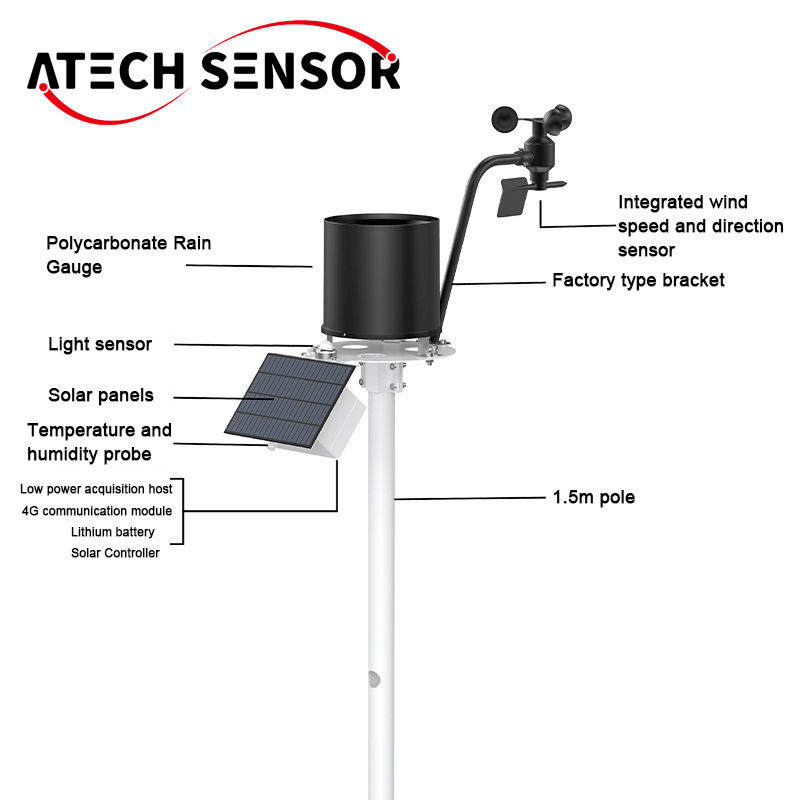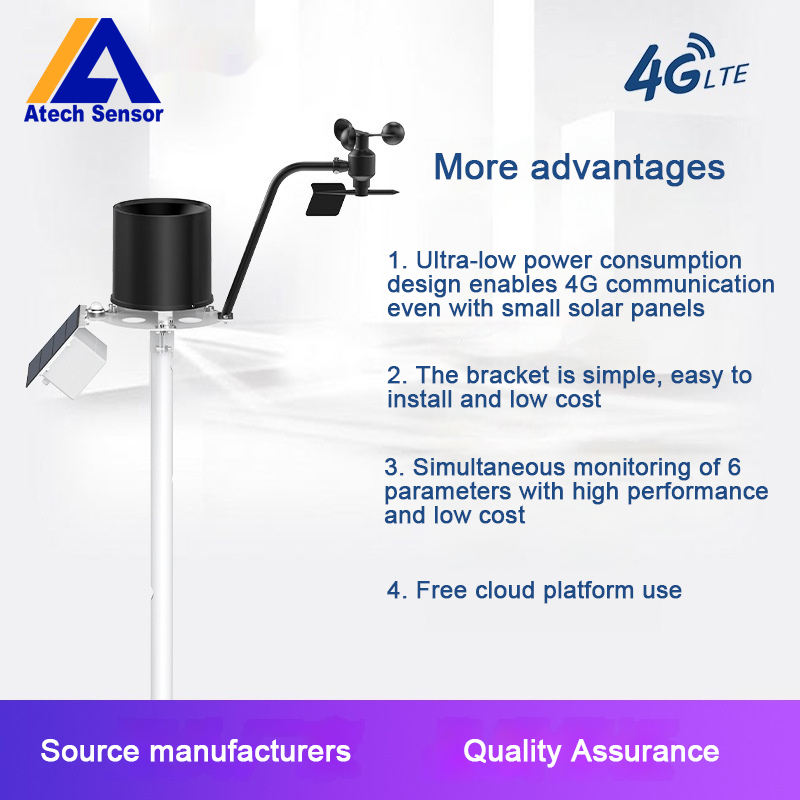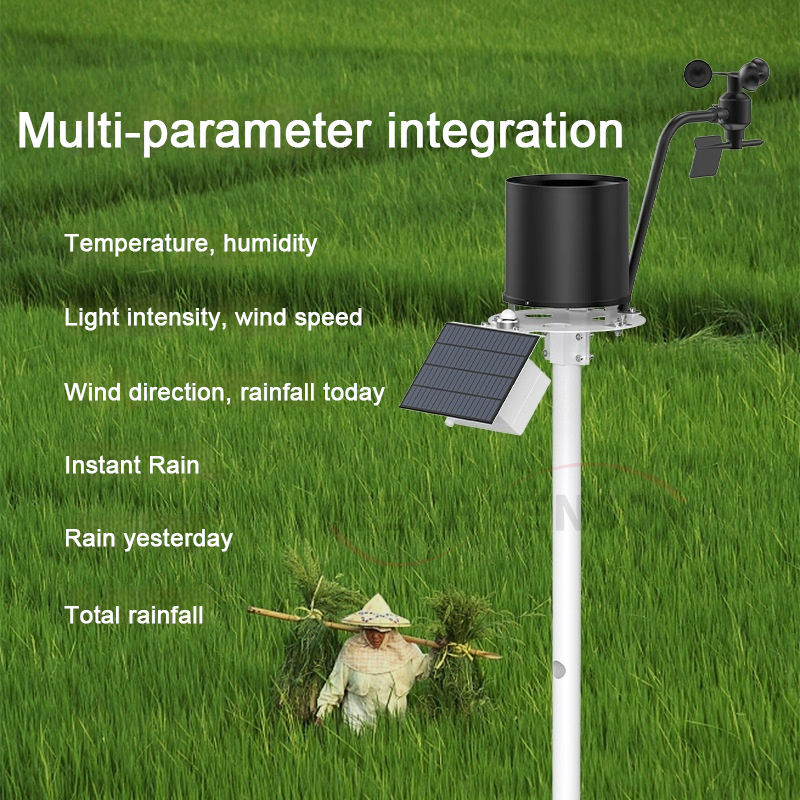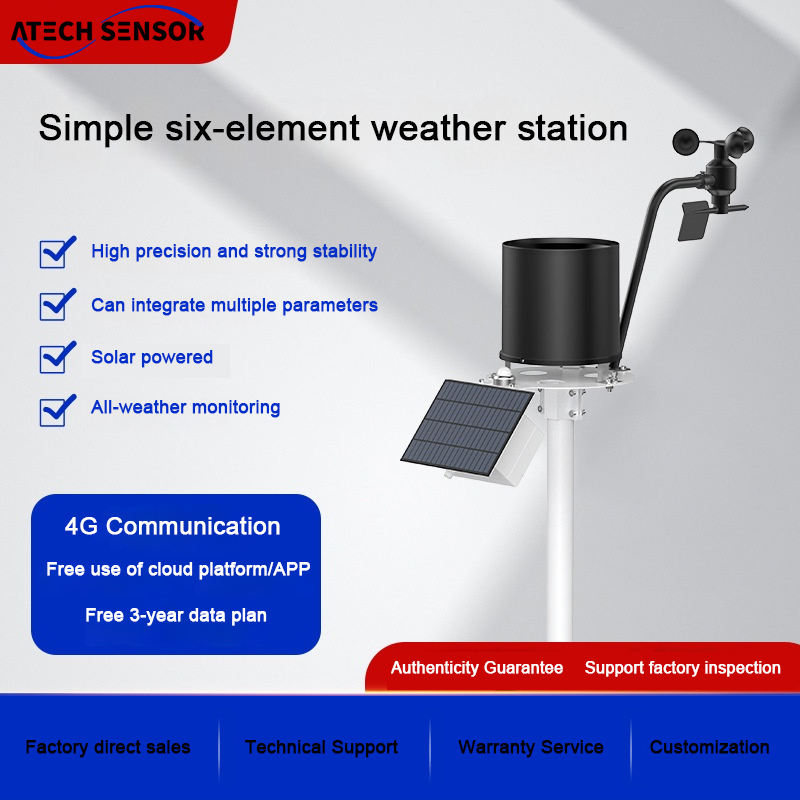1.Smart weather station
A smart weather station is a modern system for monitoring and analyzing weather data in real time. It uses advanced sensors and data processing to collect accurate weather information. This data is sent to databases or cloud platforms through wireless communication. The station offers features such as real-time monitoring, early warning systems, and detailed data analysis.
Smart weather stations can measure many weather factors. They use special sensors to do this, including:
– **CO2 Concentration**:
Tracks CO2 levels in the air. This helps us check air quality and predict climate changes.
– **Barometric Pressure**:
It measures how heavy the air is. This helps us forecast the weather and learn about the climate.
– **Rainfall**:
We measure rainfall with tools like tipping buckets or rain gauges. This helps us control floods and plan water use.
– **Wind Speed and Direction**:
Sensors measure how fast the wind blows and which way it goes. This information is important for flying, navigation, and predicting the weather.
– **Illuminance**:
Measures the strength of sunlight. It is important for solar power research and farming.
– **Air Temperature and Humidity**:
This section gives details about the weather. This information helps with forecasting, farming, and keeping people comfortable.
– **Air Temperature and Humidity**:
This section gives details about the weather. This information helps with forecasting, farming, and keeping people comfortable.
– **Soil Temperature and Humidity**:
This checks the soil to improve watering and help crops grow.w.
– **Air Quality**:
Measures pollutants such as PM2.5, PM10, and volatile organic compounds (TVOCs) for environmental checks.
– **Solar Radiation**:
This measures the solar energy we can use. It is important for solar power.
– **Snow Depth**:
This shows how much snow is on the ground using special sensors.
– **UV Intensity**:
Measures UV radiation levels for health and environmental research.

2.Key Sensors Used in Smart Weather Stations
Smart weather stations employ a variety of sensors, each tailored to specific measurements:
– **Anemometers and Wind Direction Sensors**:
These are tools that measure how fast the wind blows and which way it goes.
– **Rain Gauges**:
Use tipping bucket or piezoelectric types to measure rainfall.
– **Temperature, Humidity, and Atmospheric Pressure Sensors**:
For a detailed look at weather conditions.
– **Solar Radiation Sensors and UV Sensors**:
These sensors measure how strong the radiation is.
– **Soil Moisture and Temperature Sensors**:
Important for precise farming.
Features Making the Weather Station “Smart”
The intelligent aspect of smart weather stations lies in their advanced technology and efficiency:
1. **High-Precision Sensors**:
Use technology that cuts down interference to make data more accurate. For example, use ultrasonic sensors to measure wind.
2. **Data Processing Capabilities**:
These stations have microprocessors that store, analyze, and send data in real time. They use AI and big data to predict trends and give useful insights.
3. **Wireless Communication Technology**:
Use tools like GPRS, Wi-Fi, or LoRa. These tools help you monitor and share data from afar.
Smart weather stations are useful tools. Also help with environmental monitoring, farming, and managing disasters.
They are important for understanding climate change. They help us use resources wisely and make good decisions. This is based on accurate, up-to-date weather data.
Data analysis is done with built-in algorithms or a cloud-based analytics platform. This helps with quick data processing and early analysis.
IoT technology helps with remote monitoring and management. It allows data to be sent and equipment status to be checked in real time.
Data collection automation works well with sensors. These sensors gather weather information all the time without needing people to help.
The early warning system automatically sends alerts based on data analysis. This helps take quick action against unusual weather conditions.
One main benefit of smart weather stations is that they automate tasks. This is clear in a few key areas:
– **Automatic Data Collection**:
Sensors gather weather data all day and night without any human help. This allows for constant monitoring.
– **Real-Time Data Transmission**:
Users get constant updates with the latest weather information whenever they need it.
– **Automated Alerts**:
The system sends alerts automatically when it detects unusual weather patterns. This helps users take quick action.
– **Labor Efficiency**:
Automation lowers the need for manual labor, which greatly cuts costs.
– **Improved Efficiency**:
Fast data handling and sharing speed up weather monitoring. This helps in making quick decisions.
– **Reliability**:
Less human error makes data more accurate, stable, and trustworthy.
– **Ease of Maintenance**:
Modular designs streamline maintenance and system upgrades.
– **Automated Data Analysis**:
Integrated algorithms and cloud platforms look at data and make reports. This helps people make smart choices easily.
3.To allow real-time data transmission, smart weather stations take several clear steps:
1. **Data Collection**:
Sensors measure key weather factors. These include temperature, humidity, wind speed, wind direction, air pressure, and rainfall.
2. **Data Processing**:
A built-in microprocessor or data collector helps with the first steps of processing. This makes sure the data is accurate and complete.
3. **Wireless Communication**:
The processed information is sent to servers or cloud platforms that are far away. This uses technologies like GPRS, 3G/4G, LoRa, Wi-Fi, or satellite communication.
4. **Network Transmission**:
Data moves safely over the Internet or special channels. It goes to places like weather centers or user terminals.
5. **Real-Time Access**:
Users can easily get weather data on their mobile devices, computers, or other platforms.
6. **Data Storage**:
Data that is sent at the same time is saved. This helps with past analysis and future predictions.
Real-time data transmission relies on modern communication technologies and IoT integration. Wireless modules like GPRS, 4G/5G, LoRa, Wi-Fi, and satellite communication allow quick uploads of weather data for analysis. Cloud platforms help store and process data. They also give users easy access from computers or devices for better monitoring and forecasting.

4.The benefits of smart weather stations are:
– **High Precision**: Advanced sensors provide great accuracy.
– **Real-Time Monitoring**: Get constant updates on different weather elements.
– **Smart Data Processing**: AI analytics give useful insights for planning and making decisions.
– **Versatility**: It works well in both cities and remote areas.
5.However, these systems have some drawbacks:
– **Higher Equipment Costs**: Using high-precision sensors and advanced technologies increases costs.
– **Energy Dependency**: We use renewable energy sources, such as solar power. However, some areas still need a dependable conventional power supply.
Smart weather stations are advanced systems. They track weather conditions with modern sensors. They also use data processing and communication technologies.
These systems have many benefits, but they also have challenges. They can be costly to purchase. They depend on a network connection and a power source. Also, they require special skills for upkeep.

6.Application Scenarios and Benefits
Smart weather stations are important in many ways. They give accurate weather data for various uses.
– **Weather Forecasting and Research:**
Improve the accuracy of weather forecasts and check meteorological models by gathering detailed atmospheric data.
– **Agriculture and Forestry:**
Enhance crop planting, watering, fertilizer use, and pest control for better yield and quality. Use real-time environmental data to help make these choices.
– **Aviation and Navigation:**
Give pilots and sailors accurate data on wind speed, direction, rain, and visibility for safe operations.
– **Urban Environmental Monitoring:**
This helps with city planning.
It also protects the environment.
We track climate factors like temperature, humidity, and wind.
– **Using Renewable Energy:**
Find the best places for wind and solar energy by looking at weather data.
– **Disaster Warning and Emergency Response:**
Set up early alerts for bad weather. This helps lower damage and keep things running smoothly.
7.Agricultural Use Case: Precision Farming
Smart weather stations offer great benefits to farming. They help farmers use better ways to manage their work.
– **Smart Irrigation:**
Change water plans based on soil and air moisture levels to save resources.
– **Pest Control:**
Keep an eye out for pests or diseases. Look for changes in temperature and humidity.
– **Crop Growth Optimization:**
Use light and temperature data to plan planting times and control growing conditions.
– **Disaster Preparedness:**
Provide early warnings for severe weather events.
This includes storms and heavy rain.
8.The goal is to protect crops and reduce losses.
– **Fertilizer Management:** “Use sensors to check soil temperature, humidity, and nutrients. This helps you apply fertilizers effectively.”
– **Smart Greenhouse Control:** Automatically manage greenhouse conditions for the best plant growth.

9.Summary
A smart weather station is a high-tech system. It measures and analyzes weather data in real-time.
These stations collect and process weather data on their own. They offer helpful insights for better weather forecasts, disaster management, farming, city planning, renewable energy projects, and more.

